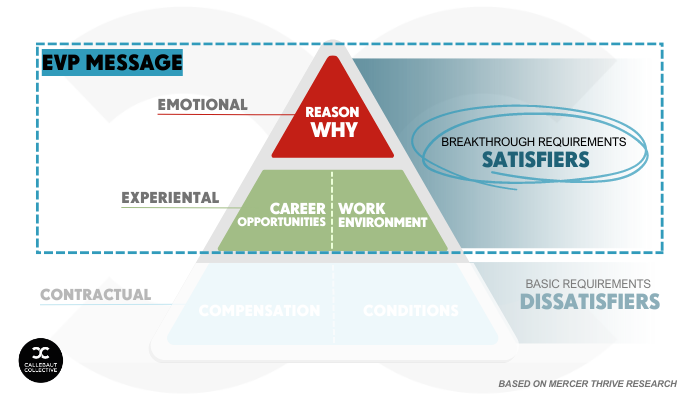09.05.23

09.05.23

After discussing how to define your EVP in article #2, according to the three key perspectives and clearly structured according to the pyramid, it is now time to write out your EVP message. This is the core message within your employer branding communication that clearly conveys how your company is unique and what it has to offer. In addition, you can define which parts of your EVP message are best communicated at what point in the funnel.
To go from building the EVP in the form of the pyramid to communicating your EVP, it is a necessary step to capture your recruiting and encompassing EVP message. Since you have already extensively thought about the content of your EVP before this, this is primarily a creative exercise. How do you put into words what your employees can expect from you as an organization, in a clear, triggering and inspiring way?
First, it is good to know that the EVP message focuses on conveying the top two layers of the pyramid, being the career prospects and work environment as well as the raison d’être. So you don’t actually include the bottom layer with basic conditions in your active communication.

Why, you might ask? As an employer, you primarily want to express the factors that actively and positively contribute to your employees’ interest and engagement. So your message deliberately focuses on the satisfiers, which focuses on the employees’ experience as well as their emotional connection. This does not mean that you never name or communicate the lower components, but in a different way and at a different time in your employee’s journey.
Compensation and benefits are often more individually oriented and thus are also communicated personally, not collectively. Moreover, they come up at very specific stages in the employee journey: with potential employees at a later, almost conversion stage, and with existing employees on the occasion of an annual evaluation moment, for example. In short, they will never be the starting point of a solid, sustainable EVP. For that, we focus on the factors that make a positive difference.
After that, it’s just a matter of putting the satisfiers of your EVP into an engaging message. Some tips:
Result: an EVP message that is completely tailored to the target audience and will be all the more useful and valuable.
To get a good view on which channels you must use to communicate to your target audiences best, and which part of your EVP you best highlight at what time, the employee journey is a useful tool. By mapping the ’employee journey‘ of your people – from the moment of their very first contact with your organization to the long-term journey in which they evolve into ultimate ambassadors – you reveal where you can make the difference or where things are not going well. And respond to that, of course, with the right message via the right channel at the right time.
In your EVP message you consciously focus on the upper layers of the pyramid, being the components that contribute to the perception and emotional connection of your employees. After all, these are the satisfiers where you as an organization can make a positive difference. A number of tips will help you put your message in words attractively, but it is also advisable to map out your employees’ journey. In this way you can learn when to deliver which part of the message and via which channels.
Want to learn more about the employee journey, and how to map it out? Or would you like to discuss how to approach your employer branding? Feel free to contact us!


© 2024 Callebaut Collective. All Rights Reserved.